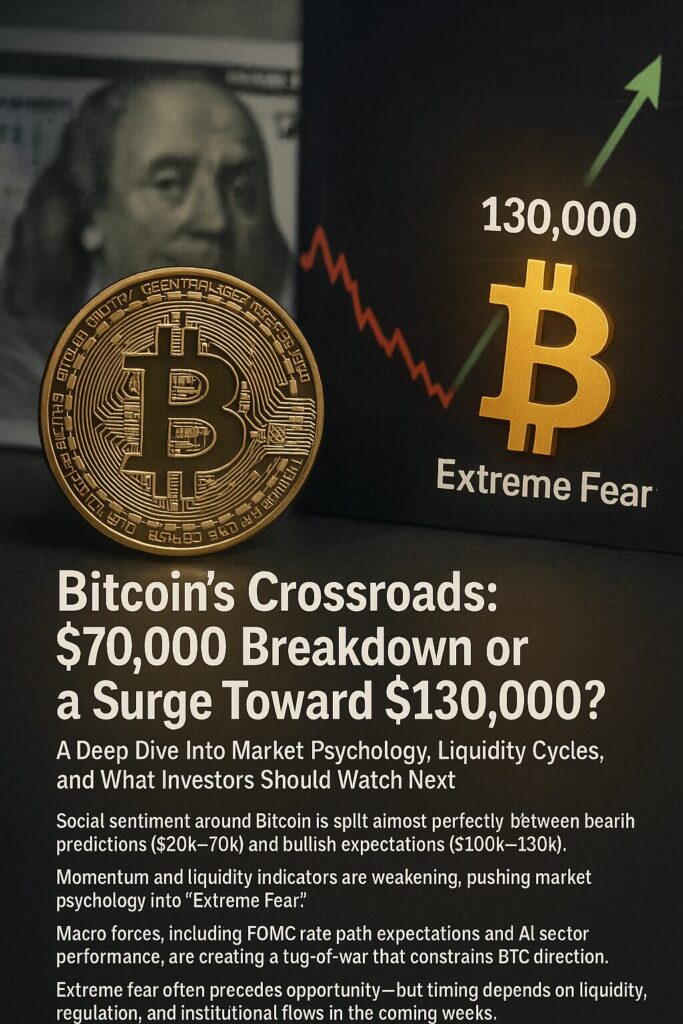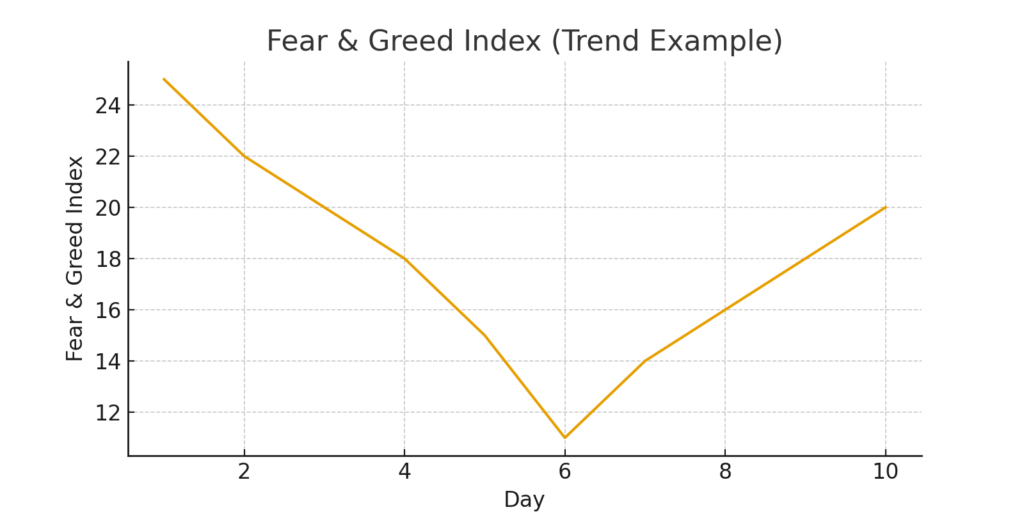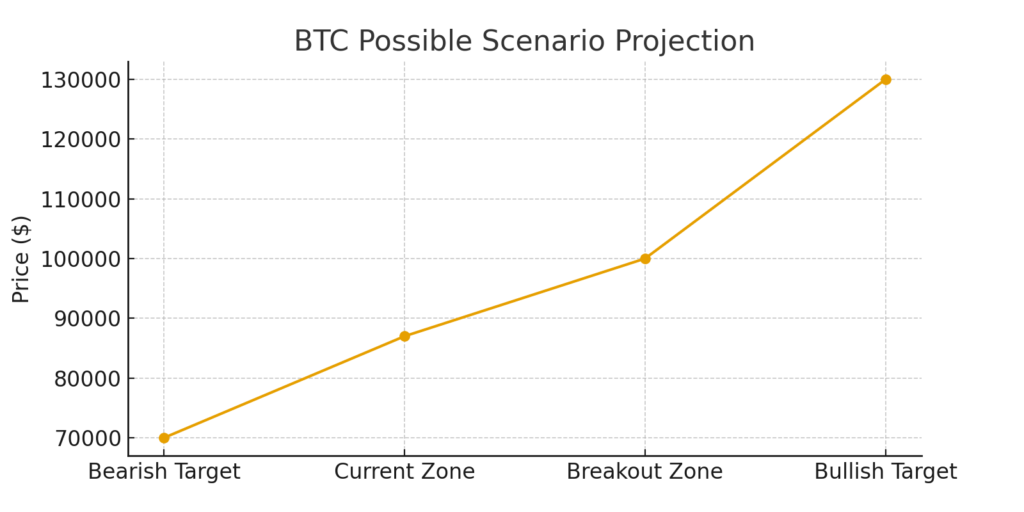
Main Points :
- Social sentiment around Bitcoin is split almost perfectly between bearish predictions ($20k–$70k) and bullish expectations ($100k–$130k).
- Momentum and liquidity indicators are weakening, pushing market psychology into “Extreme Fear.”
- Macro forces, including FOMC rate path expectations and AI sector performance, are creating a tug-of-war that constrains BTC direction.
- Extreme fear often precedes opportunity—but timing depends on liquidity, regulation, and institutional flows in the coming weeks.
- Traders seeking new crypto assets and yield opportunities must understand Bitcoin’s volatility cycles to position effectively.
1. The Market at a Breaking Point
Bitcoin recently dipped below $87,000, its lowest level since April. As it hovers near critical psychological levels, trader sentiment on social networks has fractured into two opposing camps:
- Bearish crowd: Predicting declines toward $70,000, or even extremes as low as $20,000.
- Bullish crowd: Anticipating a massive breakout toward $100,000–$130,000.
According to analytics platform Santiment, the volume of bearish and bullish posts is nearly equal—a rare event that highlights market indecision. Historically, these “sentiment ceilings” correspond to major pivots in price direction.

Santiment further noted that sentiment turned even more negative heading into Friday, suggesting the crowd increasingly expects deeper declines. In typical market behavior, prices often move in the opposite direction of the majority view, especially when retail confidence collapses.[Insert Image Here: Market Sentiment Split Diagram]
sentiment_split.png
2. Why Bitcoin Is Being Pulled in Opposite Directions
Nick Packlin, co-founder of CoinBureau, describes today’s market as a “tug-of-war between bullish and bearish narratives.” Two major macro currents are at play:
1. Fading expectations of a December FOMC rate cut.
Fewer rate cuts mean tighter liquidity—traditionally bearish for BTC.
2. Nvidia’s blowout earnings cooled fears of an AI-bubble meltdown.
Confidence in tech risk-assets spilled over into Bitcoin, creating upward pressure.
Packlin notes that if positive sentiment continues through the weekend, Bitcoin may follow. But the next major resistance lies near $107,500, a level that may determine whether BTC can retest its all-time highs or be rejected into a deeper correction.
3. A Market Dominated by Fear—And Why That Matters
Rachel Lucas, an analyst at BTC Markets (Australia), reports that multiple technical indicators—momentum, money flow, and volume—are all deteriorating. This weakening structure mirrors the sudden erosion in investor psychology.
The Fear & Greed Index, although recovering to 14, remains deep within the “Extreme Fear” category. Yesterday’s level of 11 was the lowest since February.
Extreme fear historically precedes major buying opportunities—but only when liquidity conditions begin to improve.

Lucas explains that volatility is currently amplified by four converging forces:
- Macro risk (rates, inflation, geopolitics)
- Liquidity drain across global markets
- Risk-off behavior from large investors
- Historical Bitcoin cycle patterns
She warns that investors now face a difficult environment. Whether this is the start of a deeper correction or the early setup for a rebound will depend on:
- Liquidity in the next 2–3 weeks
- Regulatory actions globally
- Institutional inflows from ETFs and funds
4. Recent Global Developments That Could Influence Bitcoin
To complement the original article, here are recent developments across the global crypto landscape that affect BTC’s trajectory and broader opportunities for traders seeking new assets:
A. Spot Bitcoin ETFs Continue Absorbing Capital
Large U.S. ETF issuers such as BlackRock and Fidelity continue to record net inflows even during downturns. These flows act as a liquidity cushion, preventing sharp collapses unless macro factors intensify.
This institutional participation supports the idea that downside may be limited without a major economic shock.
B. Liquidity Rotation Into Solana, AI Tokens, and RWA Markets
When Bitcoin stalls, capital often rotates into:
- Solana (SOL) ecosystems
- AI-linked crypto assets
- Real-World-Asset (RWA) tokens backed by treasuries or yield-bearing instruments
This rotation suggests investors are still searching for new opportunities, not exiting the market entirely.
C. Hashrate Continues Rising, Signaling Miner Confidence
Bitcoin’s network fundamentals remain strong. Hashrate and mining difficulty continue to climb—an indicator that miners, who historically lead price cycles, remain confident despite short-term volatility.
5. Practical Implications for Investors Seeking New Crypto Opportunities
For readers interested in finding new assets, yield opportunities, or practical blockchain applications, the current environment presents several strategic considerations:
A. Extreme Fear Creates Mispricing—But Timing Is Everything
Buyers who enter before liquidity improves risk catching a falling knife.
But waiting too long often means missing the early leg of a major rally.
A staggered strategy—dollar-cost averaging during deep fear—remains an effective approach for both Bitcoin and high-conviction altcoins.
B. Watch Liquidity Conditions (Not Just Price)
Key indicators:
- Global M2 money supply trends
- U.S. Treasury liquidity
- Stablecoin supply growth (USDT/USDC on-chain)
- ETF inflows
If stablecoin supplies start expanding again, it often precedes broad market recoveries.
C. Opportunities in Infrastructure, Layer-2, and Tokenized Assets
Regardless of BTC direction, structural growth continues in:
- Layer-2 scaling (e.g., Optimism, Base, zk ecosystems)
- DePIN networks (decentralized physical infrastructure)
- Tokenized treasury markets (US treasury-backed stable assets)
- Cross-chain payment networks
These present medium- and long-term opportunities with less reliance on BTC’s short-term swings.

6. Conclusion: Bitcoin’s Future Hinges on Crowds, Liquidity, and Regulation
Bitcoin currently sits at a psychological and technical crossroads, with social sentiment perfectly split between collapse and breakout scenarios. History shows that extreme fear often marks the beginning of opportunity—but only when liquidity, regulation, and institutional flows begin to align.
Over the next few weeks, traders should closely monitor:
- Liquidity trends across global markets
- ETF and institutional inflow data
- Regulatory actions affecting U.S. and Asian markets
- Stablecoin supply behavior
For investors seeking new crypto assets, alternate income opportunities, or practical blockchain applications, this environment—though volatile—remains fertile with opportunity if approached with discipline and risk control.

